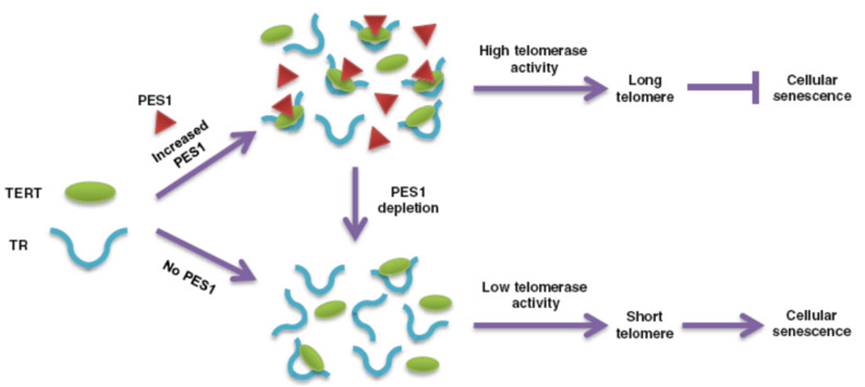Recently, the research team directed by Prof. GAO Shan at Suzhou Institute of Biomedical Engineering and Technology of Chinese Academy of Sciences, and Prof. YE Qinong at Collaborative Innovation Center for Cancer Medicine, and Prof. YANG Xiao at National Center for Protein Sciences, jointly reported that PES1 is an important regulator of telomerase.
The Nobel Prize in Physiology or Medicine was awarded to Elizabeth H. Blackburn, Carol W. Greider and Jack W. Szostak in 2009 for discovery of the mechanisms in telomeres protecting chromosomes and the enzyme telomerase. Telomerase defers the onset of telomere shortening and cellular senescence by adding telomeric repeat DNA to chromosome ends and its activation contributes to carcinogenesis. Telomerase minimally consists of the telomerase reverse transcriptase (TERT) and the telomerase RNA (TR). However, how telomerase is assembled is largely unknown.
To identify additional components of the human telomerase holoenzyme assembly, the scientists purified hTERT complexes from human cancer cells by co-immunoprecipitation (Co-IP) and examined hTERT-interacting partners with mass spectrometry.
They identify PES1 (also known as Pescadillo), which as a component of active telomerase complex, has been shown to be upregulated in many cancers and can regulate cell cycle progression as well as the synthesis and maturation of ribosome.
They find that PES1 increases telomerase activity without affecting the expression of hTERT or hTR. Moreover, PES1 regulates telomere length and cellular senescence. Mechanistically, PES1 facilitates telomerase assembly by promotion of direct interaction between hTERT and hTR.
High PES1 expression in cancer patients is associated with worse overall and relapse-free survival. Cancer cell growth is inhibited by knocking down PES1 in vitro and in nude mice. Thus, targeting PES1 may open a new avenue for cancer treatment.
This paper entitled “PES1 is a critical component of telomerase assembly and regulates cellular senescence” has been published in Science Advances.
This work was supported by the National Natural Science Foundation and the National Key Research and Development Program of China.

Figure: A proposed model underlying the role of PES1 in regulating telomerase assembly and cell senescence. Telomerase minimally comprises TERT and TR. When PES1 expression levels are elevated in some cases (e.g., cancer), it facilitates assembly of TERT and TR by forming a complex with TERT and TR, resulting in high telomerase activity, long telomere, and deferred cell senescence. PES1 depletion has the opposite effects.(Image by GAO Shan)
Contact
XIAO Xintong
Suzhou Institute of Biomedical Engineering and Technology, Chinese Academy of Sciences (http://www.sibet.cas.cn/)
Phone: 86-512-69588013
E-mail: xiaoxt@sibet.ac.cn